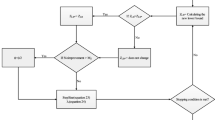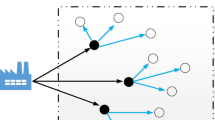Abstract
In this research, the objective is to design a multi-objective Hub-Spoke network of perishable tourism products. In order to consider the perishable factor of the products, some collection centers are considered for the products which are perished. Accordingly, the combination of Hub-Spoke network and supply chain is assessed here. Moreover, this combination is to use transportation discounts in the supply chain network. The desired combination is done in such a way that the distributors are considered as a set of hubs. As the first objective is to reduce network costs and the second objective is to reduce the emission of environmental pollutants, for the model-based solution method, a combined solution method of meta-heuristic algorithm with machine learning technique has been developed, called Multi-Objective Artificial Immune System algorithm with Machine Learning (ML-MOAIS). Also, MOAIS and NSGA-II algorithms have been used to evaluate this solution method. Employing machine learning (ML) approach leads to limiting the space for problem solving and the faster convergence of the solutions to a feasible solution. This is time-saving and cost-effective. Evaluations and comparisons have been performed in two groups of qualitative and quantitative indicators and the results show that the designed algorithm has been superior to the MOAIS and NSGA-II algorithms on average in both qualitative and quantitative indicators. A detailed analysis of the indicators shows that the Pareto solutions of the proposed algorithm have a higher number, more spread around the Pareto front, and also a higher quality in terms of cost and emission of environmental pollutants.






Similar content being viewed by others
References
Adibi, M. A. (2019). Single and multiple outputs decision tree classification using bi-level discrete-continues genetic algorithm. Pattern Recognition Letters, 128, 190–196.
Adibi, M. A., & Shahrabi, J. (2014). A clustering-based modified variable neighborhood search algorithm for a dynamic job shop scheduling problem. The International Journal of Advanced Manufacturing Technology, 70(9), 1955–1961.
Ahmadi Choukolaei, H., Jahangoshai Rezaee, M., Ghasemi, P., & Saberi, M. (2021). Efficient crisis management by selection and analysis of relief centers in disaster integrating GIS and multicriteria decision methods: A case study of Tehran. Mathematical Problems in Engineering., 2021, 22.
Alumur, S. A., Campbell, J. F., Contreras, I., Kara, B. Y., Marianov, V., & O’Kelly, M. E. (2021). Perspectives on modeling hub location problems. European Journal of Operational Research, 291(1), 1–17.
Alumur, S., & Kara, B. Y. (2008). Network hub location problems: The state of the art. European Journal of Operational Research, 190, 1–21.
Boloori-Arabani, A., & Farahani, R. Z. (2012). Facility location dynamics: An overview of classifications and applications. Computers & Industrial Engineering, 62(1), 408–420.
Deb, K., Agrawal, S., Pratap, A. and Meyarivan, T. (2001). A fast elitist non-dominated sorting genetic algorithm for multi-objective optimization: NSGA-II. In Proceedings of the parallel problem solving from nature VI (PPSN-VI) conference (pp. 849–858).
Demirel, N., Özceylan, E., Paksoy, T., & Gökçen, H. (2014). A genetic algorithm approach for optimising a closed-loop supply chain network with crisp and fuzzy objectives. International Journal of Production Research, 52(12), 3637–3664.
Dukkanci, O., Peker, M., & Kara, B. Y. (2019). Green hub location problem. Transportation Research Part E: Logistics and Transportation Review, 125, 116–139.
Fakhrzad, M. B., Alavijeh, A. S., Nasab, H. H., & Mostafaeipour, A. (2019). Integration of P-Hub location problem and 3M supply chain. International Journal of Supply and Operations Management, 6(1), 11–29.
Fazli-Khalaf, M., Mirzazadeh, A., & Pishvaee, M. S. (2017). A robust fuzzy stochastic programming model for the design of a reliable green closed-loop supply chain network. Human and Ecological Risk Assessment: An International Journal, 23(1), 119–2149.
Fliege, J., & Vaz, A. I. F. (2016). A method for constrained multiobjective optimization based on SQP techniques. SIAM Journal on Optimization, 26(4), 2091–2119.
Freund, Y., & Mason, L. (1999). The alternating decision tree learning algorithm. In Icml (Vol. 99, pp. 124–133).
Gandhi, M. A. (2018). Ordering of components of green supply chain practices jointly impacting the individual components of green supply chain performance—An empirical study of the Indian automobile manufacturing sector. Archives of Business Research. https://doi.org/10.14738/abr.61.4103.
Ghodratnama, A., Tavakkoli-Moghaddam, R., & Azaron, A. (2013). A fuzzy possibilistic bi-objective hub covering problem considering production facilities, time horizons and transporter vehicles. The International Journal of Advanced Manufacturing Technology, 66(1), 187–206.
Giallombardo, G., Mirabelli, G., & Solina, V. (2021). An integrated model for the harvest, storage, and distribution of perishable crops. Applied Sciences, 11(15), 685.
Goodarzian, F., Abraham, A., Ghasemi, P., Mascolo, M. D., & Nasseri, H. (2021). Designing a green home healthcare network using grey flexible linear programming: Heuristic approaches. Journal of Computational Design and Engineering, 8(6), 1468–1498.
Han, J., Zhang, J., Zeng, B., & Mao, M. (2021). Optimizing dynamic facility location-allocation for agricultural machinery maintenance using Benders decomposition. Omega, 105, 102498.
Karimi, H., & Setak, M. (2018). A bi-objective incomplete hub location-routing problem with flow shipment scheduling. Applied Mathematical Modelling, 57, 406–431.
Khalili-Damghani, K., Tavana, M., & Ghasemi, P. (2021). A stochastic bi-objective simulation–optimization model for cascade disaster location-allocation-distribution problems. Annals of Operations Research, 3(9), 1–39.
Khanchehzarrin, S., Shahmizad, M., Mahdavi, I., Mahdavi-Amiri, N., & Ghasemi, P. (2021). A model for the time dependent vehicle routing problem with time windows under traffic conditions with intelligent travel times. In RAIRO—Operations research.
Maiyar, L. M., & Thakkar, J. J. (2019). Modelling and analysis of intermodal food grain transportation under hub disruption towards sustainability. International Journal of Production Economics, 217, 281–297.
Masaeli, M. (2017). Shipment scheduling in hub location problems: A thesis presented to the University of Waterloo in ful_lment of the thesis requirement for the degree of Master of Science in Management Sciences, USA.
Mittal, K. V., Sindhwani, R., Kalsariya, V., Salroo, F., Sangwan, K. S., & Singh, P. L. (2017). Adoption of integrated lean-green-agile strategies for modern manufacturing systems. In Procedia CIRP (Vol. 61, pp. 463–468).
Musavi, M. M., & Bozorgi-Amiri, A. (2017). A multi-objective sustainable hub location-scheduling problem for perishable food supply chain. Computers & Industrial Engineering, 113, 766–778.
Nunes, L. J. R., Causer, T. P., & Ciolkosz, D. (2020). Biomass for energy: A review on supply chain management models. Renewable and Sustainable Energy Reviews, 120, 109–158.
Pahlevanzadeh, M. J., Jolai, F., Goodarzian, F., & Ghasemi, P. (2021). A new two-stage nurse scheduling approach based on occupational justice considering assurance attendance in works shifts by using Z-number method: A real case study. RAIRO-Operations Research, 55(6), 3317–3338.
Pourghader Chobar, A., Adibi, M. A., & Kazemi, A. (2021). A novel multi-objective model for hub location problem considering dynamic demand and environmental issues. Journal of Industrial Engineering and Management Studies, 8(1), 1–31.
Shafipour-omran, B., Khalili-Damghani, K., & Ghasemi, P. (2020). Solving a supply chain problem using two approaches of fuzzy goal programming based on TOPSIS and fuzzy preference relations. Journal of Industrial and Systems Engineering, 13(2), 27–48.
Shirazi, H., Kia, R., & Ghasemi, P. (2021). A stochastic bi-objective simulation–optimization model for plasma supply chain in case of COVID-19 outbreak. Applied Soft Computing, 112, 107725.
Taghipourian, F., Mahdavi, I., Mahdavi-Amiri, N., & Makui, A. (2011). A fuzzy programming approach for dynamic virtual hub location problem. Applied Mathematical Modelling, 36, 3257–3270.
Taherkhani, G., Alumur, S. A., & Hosseini, M. (2021). Robust stochastic models for profit-maximizing hub location problems. Transportation Science, 55(6), 1322–1350.
Yang, K., & Liu, Y. (2015). Developing equilibrium optimization methods for hub location problems. Soft Computing, 19(8), 2337–2353.
Yavari, M., & Geraeli, M. (2019). Heuristic method for robust optimization model for green closed-loop supply chain network design of perishable goods. Journal of Cleaner Production, 226, 282–305.
Author information
Authors and Affiliations
Corresponding author
Additional information
Publisher's Note
Springer Nature remains neutral with regard to jurisdictional claims in published maps and institutional affiliations.
Rights and permissions
About this article
Cite this article
Chobar, A.P., Adibi, M.A. & Kazemi, A. Multi-objective hub-spoke network design of perishable tourism products using combination machine learning and meta-heuristic algorithms. Environ Dev Sustain (2022). https://doi.org/10.1007/s10668-022-02350-2
Received:
Accepted:
Published:
DOI: https://doi.org/10.1007/s10668-022-02350-2




